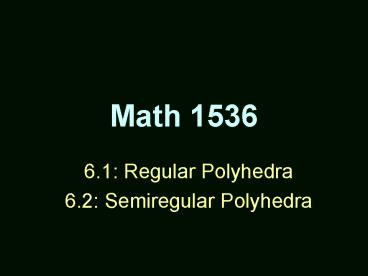Math 1536 PowerPoint PPT Presentation
1 / 18
Title: Math 1536
1
Math 1536
- 6.1 Regular Polyhedra
- 6.2 Semiregular Polyhedra
2
Review
- Before break, we studied (in 2D)
- Regular tilings
- Semiregular tilings
- Dual tilings
- Schläfli symbols
- Vector formulas for angles and area
3
Looking ahead
- For the rest of the semester, well be studying
the analogous 3-D concepts. - So the ideas should be familiar, but some of the
problems will be challenging to visualize.
4
Polyhedron
- A polyhedron is a closed 3-dimensional surface
made up of polygons, which line up along the
edges of the polygons so that the vertices match.
5
Platonic Solids
- There are only five regular polyhedra. (We built
these!) - tetrahedron, cube, octahedron, dodecahedron,
icosahedron - These are sometimes called the Platonic Solids.
6
Eulers Formula
- For any polyhedron, F V E 2where F
number of faces V number of vertices E
number of edges
7
Eulers Formula (example)
- The tetrahedron hasfour faces,four
vertices,and six edges.4 4 6 2
8
Vertex Valence
- The valence of a vertex is the number of edges
that shoot out from that vertex. - In a cube, for example,every vertex has a
valence of 3.
9
Face Valence
- The valence of a face is simply the number of
edges (sides) that surround the face. - Since the faces of an icosahedron are triangles,
every face has a valence of 3.
10
The Valence Formula
- For any polyhedron, TVV TFV 2Ewhere
TVV total vertex valence (?q(v)) TFV total
face valence (?p(f)) E number of edges
11
Spherical Deviation
- The spherical deviation at a vertex is the angle
that would need to be added to the angles already
present at that vertex to make a total of 360º.
12
Spherical Deviation (example)
- In the octahedron,every vertex touchesfour 60º
angles, for a total of 240º. - The spherical deviationat each vertex is 120º.
13
Descartes Formula
- (Note the book spells this wrong.)
- For any polyhedron, TSD 720ºwhere TSD
total spherical deviation (??(v))
14
Truncation
- Truncation is the process of slicing off
vertices of a polyhedron in order to create a new
(different) polyhedron.
15
Truncation (example)
- Start with a regular tetrahedron. Choose a
vertex, and make a mark 1/3 of the length along
each edge that extends from that vertex. Cut off
the corner at that vertex, then do the same thing
for each of the other vertices.
16
Truncation (example)
- The result is the truncated tetrahedron, and is
pictured in the margin on page 114.
17
Truncated tetrahedron
- Notice that the truncated tetrahedron is not
regular (it has two different kinds of faces). - But every vertex has the same Schläfli symbol
3.6.6. When every vertex has the same symbol,
the polyhedron is semiregular.
18
Group Work
- In groups of 2 or 3 people, complete exercises 2
and 3 on page 113. (Your drawings dont have to
be perfect.) - Also find the Schläfli symbol for each of the
resulting polyhedra. - Do not hand these in!

